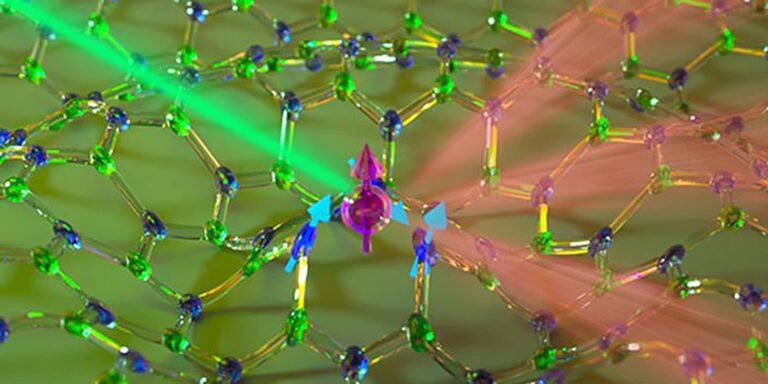
Quantum technology depends on the qubit, built with an atom, subatomic particle, or photon. In an electron or nuclear spin qubit, the familiar binary “0” or “1” state of a classical computer bit is represented by spin, a property that is loosely analogous to magnetic polarity—meaning the spin is sensitive to an electromagnetic field. To perform any task, the spin must first be controlled and coherent or durable.
Purdue University researchers have unlocked a new area of quantum science and technology by utilizing photons and electron spin qubits to regulate nuclear spins in a two-dimensional material. They used electron spin qubits as atomic-scale sensors to effect the first experimental control of nuclear spin qubits in ultrathin hexagonal boron nitride.
The study could lead to applications such as atomic-scale nuclear magnetic resonance spectroscopy. It could also allow reading and writing quantum information with nuclear spins in 2D materials.
Corresponding author Tongcang Li, a Purdue associate professor of physics, astronomy, and electrical and computer engineering, said, “This is the first work showing optical initialization and coherent control of nuclear spins in 2D materials. Now we can use light to initialize nuclear spins, and with that control, we can write and read quantum information with nuclear spins in 2D materials. This method can have many different applications in quantum memory, quantum sensing, and quantum simulation.”
Scientists first established an interface between photons and nuclear spins in ultrathin hexagonal boron nitrides.
The surrounding electron spin qubits can optically initialize the nuclear spins or set them to a known spin. Once initialized, a radio frequency can be used to “write” information by changing the nuclear spin qubit or “read” information by measuring changes in the nuclear spin qubits. Their technique uses three nitrogen atoms at once and has coherence periods more than 30 times longer than those of electron qubits at ambient temperature. Additionally, a sensor can be incorporated into the 2D material by physically layering it on top of another material.
Li said, “A 2D nuclear spin-lattice will be suitable for large-scale quantum simulation. It can work at higher temperatures than superconducting qubits.”
Researchers started by removing a boron atom from the lattice and replacing it with an electron to control a nuclear spin qubit. Three nitrogen atoms surround the electron at this time. Each nitrogen nucleus is currently in a random spin state, which can be either -1, 0, or +1.
Next, the electron is pumped to a spin-state of 0 with laser light, which has a negligible effect on the spin of the nitrogen nucleus.
Finally, a hyperfine interaction between the excited electron and the three surrounding nitrogen nuclei forces a change in the spin of the nucleus. When the cycle is repeated multiple times, the spin of the nucleus reaches the +1 state, where it remains regardless of repeated interactions. With all three nuclei set to the +1 state, they can be used as a trio of qubits.
Journal Reference:
- Tongcang Li, Nuclear spin polarization and control in hexagonal boron nitride, Nature Materials (2022). DOI: 10.1038/s41563-022-01329-8.